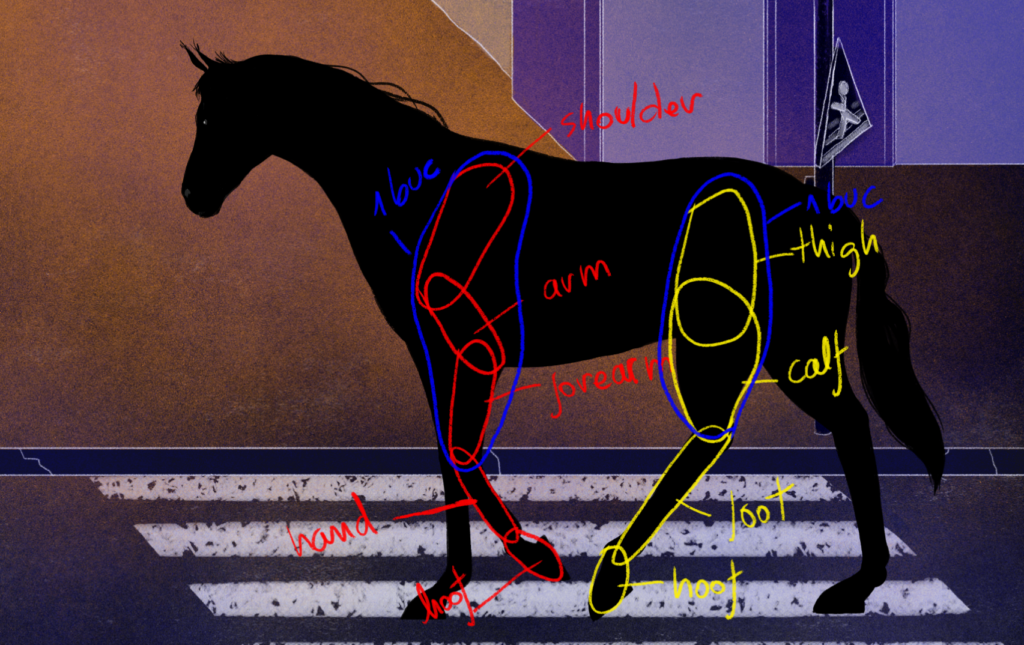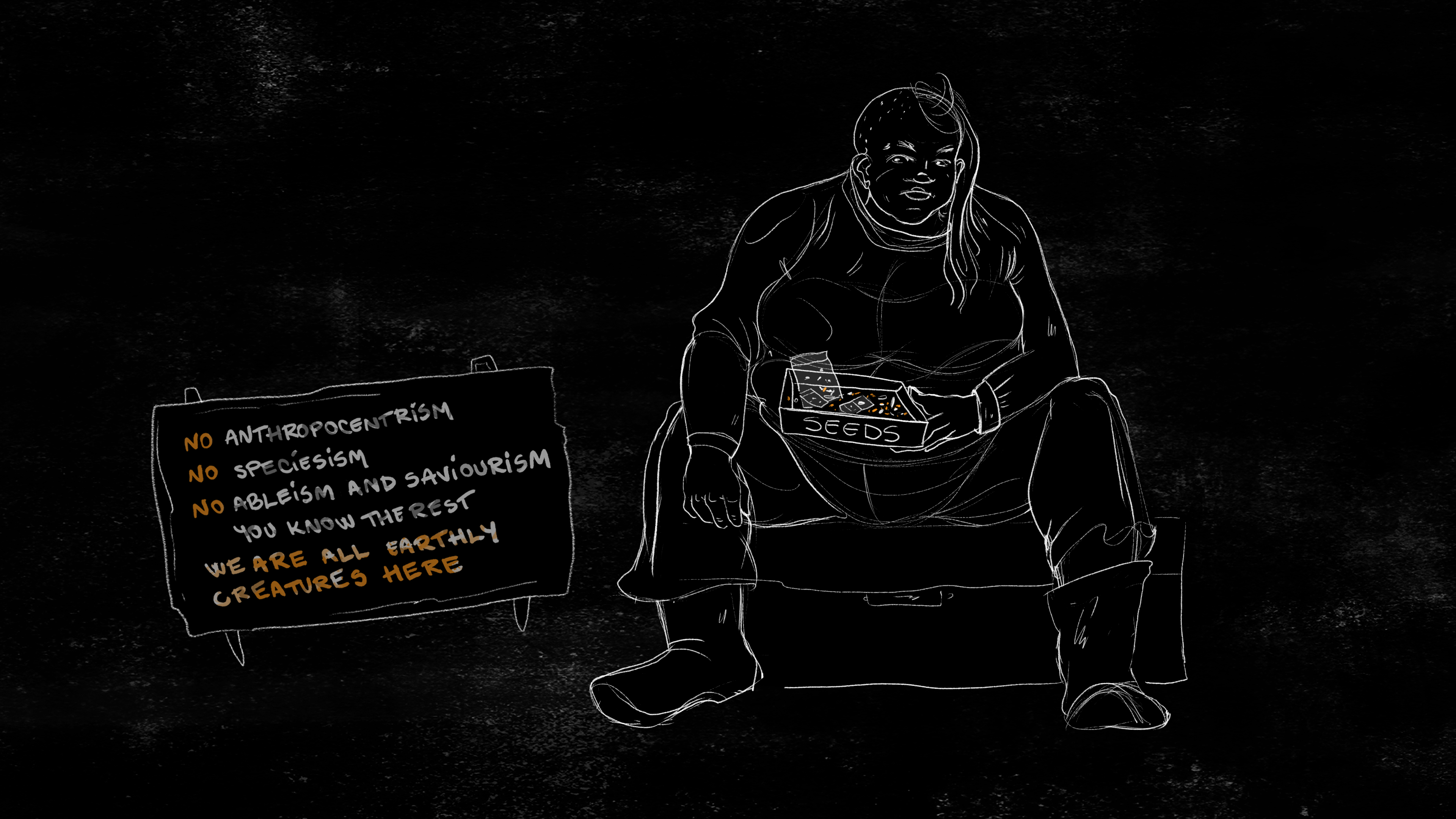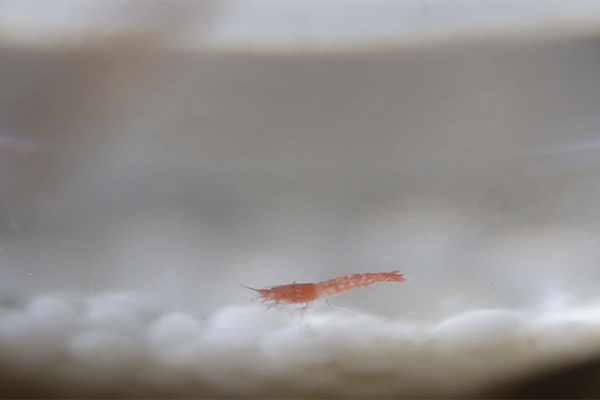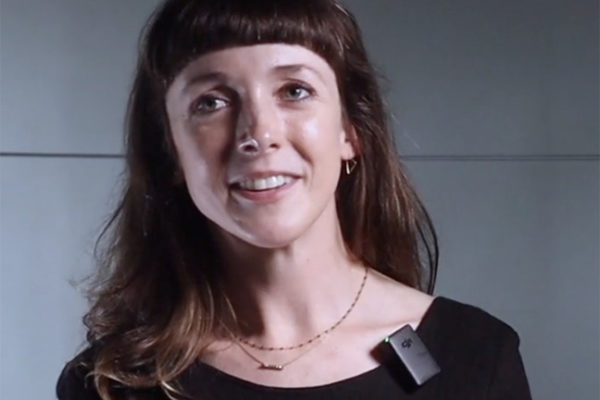Gauri Kasarla is a 2023 CAF Navab Fellow from Columbia University studying Art History and Visual Art. She spoke with 2020 CAF grantees Just Wondering . . . , a multidisciplinary team of antispeciesist creatives, based in Romania.
Escucha la traducción de la entrevista en español en la voz de Laura Alvear Roa.
Q: How does just wondering . . . conceive of its animations?
 If you ask each of the three of us co-producing the animations, every one of us will conceive of them differently—that’s certain. A friend of ours told us that we don’t make political narratives, but narrative politics! We think that’s a good way to look at our animations.
If you ask each of the three of us co-producing the animations, every one of us will conceive of them differently—that’s certain. A friend of ours told us that we don’t make political narratives, but narrative politics! We think that’s a good way to look at our animations.
We started this project with some skills but lacked others. We thought: How can we use our artistic abilities and strengths as visual artists and graphic designers—because the two of us starting this (Mina and Aron) knew how to draw, create graphics, and so on—to question common narratives? You won’t see either one of us jumping on a stage to give speeches; we never liked to have our faces in the forefront and we both deal with social anxiety. So, just wondering . . . was a way to express ourselves. We wanted to explore critical ideas and philosophical questions in an animated format—things that we didn’t get the chance to do, formally or informally, before—while also giving something back to the world, poking at different discourses. That was our initial goal. So, our animations arose out of these inner tensions, desires, and anxieties, and because of this we often think of the videos as a language that’s in constant transformation.
We explore critical topics that we’re interested in and think that other people might or should be interested in. There’s a double meaning in the name of the project itself that we didn’t notice at first but fully embraced later. So, we can say with more conviction now that just wondering . . . is both an exploration and a way to engage people to think more critically about social and environmental justice issues that connect to animal issues and to the politics of veganism and total liberation more generally. We didn’t have such a good grasp of what we wanted to make when we started this project more than seven years ago, or what kind of questions we’d follow, but we were vegan and veganism was always central to the project.
Things changed a lot over the years. While the two of us starting it were both initially inclined towards the arts, one of us wanted to read and study philosophy more (Aron) and the other one (Mina) wanted to transition from sculpture to becoming an independent illustrator. M. on the other hand—the third one of us—was a sociology student and an aspiring writer when we all started to work together. M. brought a whole new paradigm to the project. But perhaps what was more in tune with our direction that we didn’t process in full depth at that time was the fact that all three of us were vegan. Because of that, we could discuss more about it and, through our friendship, develop our antispeciesist politics together. Gradually this is what made just wondering . . . more and more what it is today, moving away from simply making explanatory and exploratory videos to being a thoughtful political project engaged with social justice issues and narratives.
Moving our imagination closer to ideas of total liberation from all forms of oppression is central to all three of us and it unites our visions and different skills. So, these days we like to think that our animations explore the broader field of critical animal studies in a way that engages the audience emotionally, but also critically, with different issues: without displaying the images of the horrible treatment many animals are forced to endure, while never forgetting why we do what we do; why this kind of work is necessary; and why we need not only activist protests, direct action, documentaries, and theory, but perhaps also narrative politics to change the status quo! This is why we see our animations as a form of artivism: as points of departure from a world in need of radical change.
Q: How long does it take to create the animations?
 It all depends on the kind of production we’re committed to doing: Is it a video, a film, a keyframe, or blackboard animation that we’re trying to make? The technique used, the length, the style, and the flow, all play a role. So, there isn’t really a fixed timeframe: some productions can take weeks, others months. It’s not always visible, at first sight, why this is the case.
It all depends on the kind of production we’re committed to doing: Is it a video, a film, a keyframe, or blackboard animation that we’re trying to make? The technique used, the length, the style, and the flow, all play a role. So, there isn’t really a fixed timeframe: some productions can take weeks, others months. It’s not always visible, at first sight, why this is the case.
The videos in our playlist of “thinkers & concepts,” for example, rely on the blackboard animation technique. This means that all illustrations are being recorded by one of us, as they are drawn, so we can later combine them with the narration and music. The whole process, from start to finish, can take from a couple of weeks to up to a few months. However, when it comes to keyframe animations and more complex projects, it’s definitely a matter of a couple of months. Our short film “we fly, we crawl, we swim,” which we were able to make thanks to CAF, was made in this way. Putting everything together for the film in its final form took a bit more than seven months of constant work.
Another thing to consider when thinking about the time involved to make the animations is the fact that we research all the topics we’re writing about, and because this doesn’t happen overnight, or gradually, it’s hard to count every hour. Sometimes we read various texts and books from an author for months and then put them away and come back to them months (if not years) later when deciding to make a video. So, if we include the research and writing, it never takes less than three months. But sometimes, we produce a video essay that’s written by someone else—in which case we do editing work and then jump straight to the illustration process (starting with mood boards, color palettes, and so on). Because we’re only three people who do everything—from researching, writing, storyboarding, recording, editing audios, illustrating the scenes, merging all the elements together, and many times, also improvising with the music, all between other tasks and projects—it’s really hard to know. Sometimes other people help, but usually, it’s just us, so the simple answer is: It takes a lot of time!
Q: How are the animations made? Are they made entirely digitally or drawn using ink/paint?
 All the animations we’ve made so far were realized entirely digitally from scratch. The illustrations are created using a drawing tablet or pen-display device, and are drawn in Photoshop and Illustrator. In some cases, the drawings are recorded and then edited as we’ve mentioned before. In other instances, we export the illustrations by elements to animate them afterward in After Effects. All elements—from the video recordings to the animations, narration, sound effects, and music—will be eventually put together in Premiere into one coherent piece. So, the production of the animations relies on different digital programs and skills such as drawing or audio editing required to navigate the programs and create the type of content we want to piece together.
All the animations we’ve made so far were realized entirely digitally from scratch. The illustrations are created using a drawing tablet or pen-display device, and are drawn in Photoshop and Illustrator. In some cases, the drawings are recorded and then edited as we’ve mentioned before. In other instances, we export the illustrations by elements to animate them afterward in After Effects. All elements—from the video recordings to the animations, narration, sound effects, and music—will be eventually put together in Premiere into one coherent piece. So, the production of the animations relies on different digital programs and skills such as drawing or audio editing required to navigate the programs and create the type of content we want to piece together.

Of course, we do make storyboards sometimes using pen and paper for more complicated projects and there’s also the audio that’s not created entirely digitally, but the animation that people see on the screen in the end, that’s not made frame-by-frame using ink or paint. We did have some digital frame-by-frame animations here and there in our videos, but since these can take a lot of time to make and only two of us are drawing, animating, and editing everything, we try to stick either with keyframe or blackboard animation. At this point, most of our videos are currently made using the latter technique, although our first animations were created using the former one. Animations take a lot of patience, as creating them can be a very long and tiring process. Sometimes we think about exploring more directions and styles, but we lack the necessary time, budget, or people to radically expand our audio-visual language into an even more animated, imaginative, fantastic, or utopic side.
Creating our own path forward is key to sticking with the work, so we embrace hybridity, speculation, and imperfections even though we pay close attention to details, structure, flow, and form. The project’s difficulties, as well as our own individual challenges, interests, and eventual reorientations in life bring new becomings. We try to see them not as failures, but as bridges, as fuel that can push our work in different, unknown directions. Positioning our animations in the real world makes them personal without centering us in them, it’s about politicizing and engaging with different issues that we either struggle with or think they need a more in-depth exploration.
Q: What do you hope to achieve with your poetry and animations? What does a multispecies community look like to just wondering . . . ?
 We hope our work can bring ideas that are critical, speculative, and eventually transformative into the world, sparking all kinds of changes. We imagine these changes in a minor voice: these are the kind of transformations that don’t usually come from leaders and grandiose oratorical proposals, but from solidarity, from the margins, from understanding systems of oppression, and from mundane fears and anxieties that we struggle with, not empty and romantic promises.
We hope our work can bring ideas that are critical, speculative, and eventually transformative into the world, sparking all kinds of changes. We imagine these changes in a minor voice: these are the kind of transformations that don’t usually come from leaders and grandiose oratorical proposals, but from solidarity, from the margins, from understanding systems of oppression, and from mundane fears and anxieties that we struggle with, not empty and romantic promises.
We want people to be able to envision with us a multispecies flourishing world that doesn’t hide away from tensions and conflicts. For us, in an ideal multispecies community, critical theories and prefigurative politics would merge together, complementing each other, creating a space where all bodies and abilities are appreciated and respected. So, differences would not be constraining but liberating! This community we strive for is critical of anthropocentric values, it’s not based on an imperialist, colonialist, or humanist project, it’s anti-speciesist, anti-racist, anti-capitalist, anti-ableist, anti-sanist, feminist, queer and joyful—breaking current rules and hierarchies by challenging domineering structures constantly.
Understanding that there is no world without power and conflicts of interest is crucial for knowing how to deal with them now, or in the future. An ideal community thus knows how to face its challenges without resorting to oppressive configurations. It understands that everything has a point of view, and a position, translating the world to its own accord. It approximates not universalizes what’s “good” for other beings, because it knows that enforced generalizations can be dangerous. A multispecies community of this sort recognizes that it is part culture, part nature, and has no desire to recreate the ruptures seen in our modern times, purifying relations and beings by allocating them to fixed homogenous binaries. In our imagination, such more-than-human communities would be central to how we engage and relate with each other, not pushed to the margins. But that’s a very idealistic vision: in the world that we live in now the best we can hope for is at the margins, where resistance happens and narratives change.
Thus, multispecies communities can take many forms. But, one key aspect we consider crucial is that these spaces, either now or in the future, give themselves the chance to be zones of transformation, where living, relating, and thinking differently with other animals becomes indispensable. It’s not just a matter of protection and integration into current structures; we need to restructure everything so that those pushed to the margins can participate and are able to change how our collective lives unfold.





